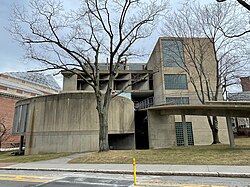
The Harvard Film Archive (HFA) is a film archive and cinema located in the Carpenter Center for the Visual Arts at Harvard University in Cambridge, Massachusetts. Dedicated to the collection, preservation and exhibition of film, the HFA houses a collection of over 25,000 films in addition to videos, photos, posters and other film ephemera from around the world and from almost every period in film history. The HFA cinematheque screens films weekly in its 188-seat theater. It also maintains a film conservation center near Central Square, Cambridge. Harvard Film Archive won the 2020 Webby Award for Cultural Institution in the category Web. [1]